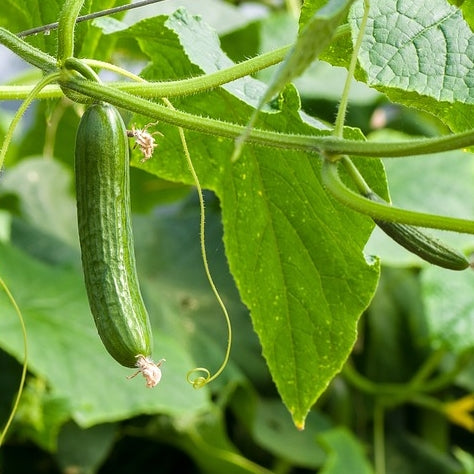-
1. Origins
The humble cucumber, known scientifically as Cucumis sativus, is a fruit that has been cultivated for over 3,000 years. It is believed to have originated in the northern plains of India, where wild varieties can still be found today. As early as 2000 BCE, cucumbers were being grown in the fertile lands of the ancient civilizations of Mesopotamia. Later, they made their way to Europe through the Romans, who valued them not only as food but also for their medicinal properties.
Over time, cucumbers have spread worldwide, and today they are an integral part of many diets and cuisines. They are especially popular in Mediterranean, Middle Eastern, and Asian cuisines.
-
2. Growing Tips and Tricks for Hydroponics
The first step in hydroponic cultivation of cucumbers is to select the right variety. We’ve done just that, for you! Mini cucumbers are an advanced plant to grow, but we’ve done our best to make it as easy possible for you.
We recommend you maintain a pH range of 5.5-6.0 for optimal nutrient absorption. For more advanced growing we recommend you use a pH sensor.
Cucumbers are a vining plant, so providing them with vertical support will improve air circulation, allow for better light penetration, and make harvesting easier. Our trellises are designed to help do just this!
Cucumbers require full light exposure, so aim for 14-18 hours of light per day. Rise recommends you stick our standard light schedule of 16 hours of light per day.
Water quality, temperature, and humidity is vital for growth and can cause benefits or issues depending on your growing environment. Keep in mind to maximize growth plants need a near perfect environment for growth, so if you face issues be sure to check your water and air quality first. Cucumbers prefer a temperature range of 65-75 degrees Fahrenheit and relative humidity around 70%.
Harvest cucumbers when they are bright green, firm, and medium-sized. As with soil cultivation, regular harvesting encourages the plants to produce more fruit.
In conclusion, hydroponic cultivation of cucumbers is an excellent way to enjoy this refreshing crop year-round, providing you with fresh cucumbers regardless of the weather outside.
-
3. Plant Scientific Information, Characteristics, and Benefits
Cucumbers are part of the gourd family, Cucurbitaceae, which also includes pumpkins, melons, and squashes. They are characterized by their sprawling vines and yellow flowers, and they are known for producing fruits (which we usually consider vegetables) with a high water content.
Nutritionally, cucumbers are a fantastic source of hydration due to their 95% water content. They also contain Vitamin K, Vitamin C, potassium, and magnesium. In addition, cucumbers are known for their antioxidant and anti-inflammatory properties. Some research suggests that cucumbers may help reduce blood sugar levels, making them a healthy choice for individuals with diabetes.
-
4. Use
Cucumbers are versatile and can be used in a variety of dishes. They are a staple in salads and sandwiches, and they are also great for pickling. Gazpacho, a cold Spanish soup, and Tzatziki, a Greek yogurt-based dip, both feature cucumbers as a primary ingredient
In addition to their culinary uses, cucumbers have found their way into skincare. They are often used in treatments to soothe skin and reduce puffiness, particularly around the eyes.
In conclusion, the cucumber is more than just a crunchy addition to your salad. It's a plant with a rich history, a plethora of health benefits, and uses that span the culinary and cosmetic worlds. Whether you're growing it in your garden or enjoying it in your meals, the cucumber is indeed a fruit (or vegetable, if you prefer) worth appreciating.



